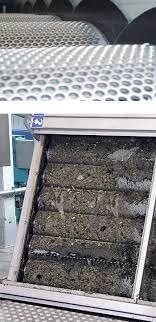
Riverside Regional Water Quality Control Plant
The Riverside Regional Water Quality Control Plant: A Pillar of Environmental Management
The Riverside Regional Water Quality Control Plant (RRWQCP), nestled in the heart of Riverside, California, serves a critical function in maintaining the region’s environmental health and sustainability. This facility, often overshadowed by more public-facing municipal services, operates as a backbone of local infrastructure, ensuring both the ecological integrity of the Santa Ana River and the wellbeing of Riverside’s residents.
Population Served and Wastewater Volume
The RRWQCP serves an estimated regional population of over 325,000 residents, encompassing not only the bustling cityscape of Riverside but also numerous surrounding communities. The plant handles a remarkable volume of wastewater, processing an average of 40 million gallons per day (MGD). This amount can surge dramatically during periods of heavy rainfall or in the event of emergency discharges, underscoring the importance of a robust and efficient treatment system.
Treatment Capacity and Technological Prowess
Designed with a treatment capacity of up to 52 MGD, the RRWQCP stands prepared for future population growth and urban development. Its state-of-the-art facilities incorporate a range of technologically advanced processes, including primary and secondary treatment stages, advanced nutrient removal, and tertiary treatment for water reclamation. These processes collectively work to remove contaminants, organic materials, and nutrients from the wastewater, ultimately producing effluent that meets stringent quality standards for discharge into the environment or reuse.
Recent Local News and Key Projects
Recent developments at the RRWQCP highlight the ongoing commitment to innovation and sustainability. Announced in late 2022, the Riverside Resilient Water Initiative aims to enhance the plant’s resilience against climate change impacts, such as more frequent and severe weather events. This ambitious project includes upgrading existing infrastructure, integrating renewable energy sources, and advancing water recycling programs.
A keystone project under this initiative is the Bioenergy Facility Expansion. Scheduled for completion in mid-2024, this expansion will double the plant’s capacity to convert organic waste into renewable energy. Utilizing anaerobic digestion technology, the facility will transform biosolids and food waste into biogas, which can then be used to generate electricity and heat. This not only helps to reduce reliance on fossil fuels but also addresses the growing concern of waste management in the region.
Another significant undertaking is the Advanced Purified Water Program. This long-term project aims to bolster local water supplies by converting treated wastewater into high-quality drinking water. By employing cutting-edge purification technologies, such as reverse osmosis and ultraviolet disinfection, the program envisions creating a sustainable, drought-resilient alternative to traditional water sources. Public feedback and regulatory approvals are currently shaping the pilot phase of this groundbreaking initiative.
Community Engagement and Educational Outreach
Recognizing that effective environmental management hinges on public awareness and participation, the RRWQCP places substantial emphasis on community engagement. Over the years, the plant has cultivated a reputation for transparency, regularly hosting open house events, facility tours, and educational workshops. These efforts are aimed at demystifying the wastewater treatment process and highlighting the role of residents in water conservation and pollution prevention.
One standout program is the annual “Waterwise Champions” campaign, which celebrates local schools, businesses, and community groups that demonstrate exemplary water stewardship. The campaign includes school outreach activities, such as science fairs and classroom presentations, where students learn about the water cycle, wastewater treatment, and the importance of protecting local water resources.
In addition, the plant’s Community Advisory Board, established in 2017, serves as a vital conduit for citizen input and environmental advocacy. Comprising a diverse array of stakeholders, including residents, environmental groups, and local business leaders, the board advises on policy decisions, project planning, and public communication strategies. Through this collaborative approach, the RRWQCP strives to integrate community perspectives into its operational and strategic framework.
Challenges and Future Directions
Despite its numerous achievements, the RRWQCP faces several challenges that necessitate ongoing innovation and adaptation. Climate change poses a significant threat, with rising temperatures and shifting precipitation patterns potentially impacting both water availability and quality. In response, the plant is exploring adaptive management strategies, such as increased water recycling and enhanced flood risk mitigation measures.
Moreover, the issue of emerging contaminants, including pharmaceuticals and personal care products, presents a growing concern. These substances, often resistant to conventional treatment processes, can pose ecological and human health risks if discharged into waterways. To tackle this, the RRWQCP is actively participating in research initiatives and pilot studies aimed at developing effective removal technologies.
Looking ahead, the plant’s strategic vision aligns with global sustainability goals, emphasizing the importance of resource recovery, circular economy principles, and integrative water management. Key future endeavors include:
-
Expansion of Water Reuse Programs: Scaling up efforts to integrate recycled water into agricultural, industrial, and landscaping applications, thereby reducing dependence on freshwater sources.
-
Decentralized Treatment Solutions: Implementing smaller, localized treatment systems in underserved areas to enhance service accessibility and resilience.
- Community-Centric Innovations: Fostering partnerships with academia, industry, and non-profits to drive forward-thinking solutions and promote environmental justice.
Conclusion: A Community Asset
The Riverside Regional Water Quality Control Plant stands as a testament to the power of community-focused environmental stewardship. It not only safeguards the health of the Santa Ana River ecosystem but also ensures the sustainable growth and resilience of Riverside and its neighboring communities. Through its commitment to technological advancement, public engagement, and strategic foresight, the RRWQCP exemplifies a forward-thinking approach to water quality management that serves as a model for municipalities nationwide.
The journey of the RRWQCP is a reminder of the crucial interplay between infrastructure, innovation, and community engagement in addressing contemporary environmental challenges. As Riverside continues to grow and evolve, the RRWQCP will undoubtedly remain a cornerstone of the region’s efforts to achieve a sustainable and resilient future.
